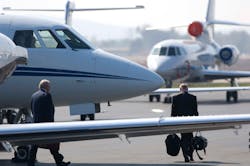As Airlines Cut Flights, Scheduled Charter Operations Are Filling the Void

Both commercial service and general aviation airports play a vital role in the nation’s air transportation system – providing freedom of mobility, attracting investment and generating employment in local communities.
The Airline Deregulation Act, passed in 1978, gave air carriers great discretion to determine which markets to serve domestically and what fares to charge for that service. Soon after, Congress established the Essential Air Service Program to help support a minimum level of scheduled air service in small communities and connect them to the nation’s transportation network.
However, as documented by the U.S. Government Accountability Office, air service to small communities has declined since 2007 and airports of all sizes have lost capacity in the number of available seats and flights offered to the traveling public.
During the COVID-19 pandemic, 68 airports across the nation lost commercial air service, negatively impacting the essential movement of people and goods. Private jet operators reacted quickly to meet the need for essential air services independent of federal funding, with aircraft operations rebounding more rapidly at general aviation airports than at commercial airports.
In some rural or remote areas where there is limited commercial service, business travelers have chosen to fly privately rather than spend an extended number of hours waiting for a connection to a larger hub.
In light of these facts, it is hard to overlook the importance of general aviation airports as commercial airlines continue to cut back on service, flights and personnel. There are approximately 5,100 public use airports in the nation accessed by general aviation aircraft, compared to approximately 500 that offer commercial airline service. This means that business aviation reaches 10 times the number of U.S. airports than do the airlines, while contributing $150 billion to U.S. economic output and employing more than 1.2 million people.
Today, there is a growing national trend for on-demand aircraft charter brokers to market and sell flights on a per-seat basis as a more affordable alternative to chartering an entire aircraft. In many cases, these third-party brokers post schedules (including the departure time, departure location and arrival location) on websites and smart phone applications that match passengers with available aircraft.
This business model for public charter flights, known as “charter by the seat,” brings private aviation to a broader, more diverse segment of the traveling public and provides essential air services to local communities. The operations are regulated by the Department of Transportation (14 CFR 380) and are considered permissible under federal rules by the Federal Aviation Administration (FAA).
However, at many of our nation’s general aviation airports, these scheduled commercial charter operations have caused some community members and public officials to question whether selling single seats on charter aircraft – particularly those with published and planned flight departure times – should be prohibited.
The public controversy seems to stem from what distinguishes a scheduled Part 121 commercial airline operation from a scheduled Part 135 charter operation. Per the FAA, Part 135 on-demand aircraft charter operators, who own or manage the aircraft, may offer up to four scheduled round-trip flights per week in an aircraft with up to nine seats. If the aircraft is configured for more than nine seats, it can only be operated at a Part 139 certificated airport.
Therefore, scheduled commercial air carrier service – including airline, regional air carrier and cargo flights – are prohibited at general airports that do not hold a Part 139 operations certificate. However, scheduled flights operated under Part 380 are permissible at those airports regardless of the aircraft type or number of seats since they are not considered scheduled by the FAA.
The DOT permits Part 380 public charter companies, who do not own or operate the aircraft, to advertise and sell single seats on flights conducted at general aviation airports in aircraft with over nine seats. If a Part 135 on-demand operator wishes to operate five or more scheduled round-trip flights per week under a published schedule, it must first obtain commuter operations specifications under Part 380 of the DOT’s regulations.
This means that in order to take advantage of the public charter rules, a Part 135 on-demand air carrier must enter an arrangement with a Part 380 public charter operator that can sell seats on the flights for which authority was granted. Only a Part 380 public charter operator may publish and advertise scheduled flights beyond what is permitted under Part 135.
Also, Part 380 of the DOT's regulations requires all persons who wish to arrange public charter flights to first submit a charter prospectus to DOT which contains information about the proposed charter program. The DOT publishes this information several times per year.
In general, public use airports have limited authority under federal law to restrict operations that can safely and legally use those airports. However, airport sponsors may exert some authority to regulate scheduled charter operators to protect airport safety and efficiency, provided the regulations are not discriminatory. Should the FAA deem such an action to result in unjust discrimination to aeronautical activities, it could result in an airport jeopardizing its federal grant assurances.
While the FAA generally recognizes the airport sponsor’s authority to regulate operations, some public charter operators are actively filing lawsuits against municipalities that seek to limit their operations. To survive a legal challenge, any regulation of public charter flights must be able to withstand a federal grant assurance challenge.
A growing issue of public concern is whether passengers buying single seats should be subject to the same security screening process as those flying on a commercial airline. Current TSA regulations state that for charter jets carrying more than 61 passengers, the passengers are required to pass through normal security. Light private jets, which normally seat anywhere from four to eight people, are therefore exempt from going through the same inspection as commercial flight passengers.
As charter industry operators and brokers bring the advantages of private air travel within the reach of more communities, important questions must be addressed. How would prohibiting public charter flights impact the inclusionary process of serving a more diverse segment of the traveling public? Is it equitable or just to transfer the noise impacts of certain aircraft operations from one community to another? How will limiting flights now considered legal by the FAA and DOT impact interstate commerce?
It seems the technology landscape is evolving so quickly that federal regulatory agencies are struggling to keep pace. It is only a matter of time until similar questions are asked about emerging industries in urban air mobility, such as eVTOL and air taxis.
To protect the integrity of our nation’s air transportation system and ensure essential air services are provided to local communities, policy discussions must take place at the federal level.
Curt Castagna, president and CEO of Aeroplex Group Partners, is also president and CEO of the National Air Transportation Association, the immediate past chair of the Los Angeles County Airport Commission, and president of the Van Nuys and Long Beach airport associations. A certified private and instrument-rated pilot, he continues to instruct courses in aviation administration at Cypress Community College and Cal State Los Angeles.
About the Author

Curt Castagna
President and CEO
Curt Castagna, President/CEO of Ascension Group Partners, serves as president and CEO of the National Air Transportation Association, member and past chair of the Los Angeles County Airport Commission, and president of the Van Nuys and Long Beach airport associations. A certified private, seaplane and instrument-rated pilot, he continues to instruct courses in aviation administration at Cypress Community College and Cal State Los Angeles.